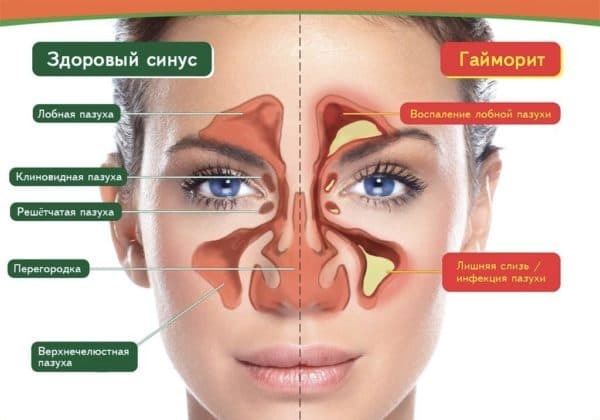
Free breathing is one of the main signs of our health. Full penetration of air provides ventilation of the lungs and bronchi, saturates the blood with the right amount of oxygen. But often, especially in the off-season, our breathing begins to suffer. The cause of this can be multiple diseases:
- sinusitis;
- sinusitis;
- allergy;
- complications after previous infections;
- disorders in the structure of the nose congenital or acquired.
How is treatment of maxillary sinusitis with Azithromycin, you can find out by reading the article.
Most often a person has to face the most formidable enemy of the nose: sinusitis.
Contents
- 1 What is antritis and its features
- 2 Predisposition and causes of sinusitis
- 3 Primary signs of sinusitis
- 4 Diagnosis of the disease
- 5 Methods and methods of treatment
- 5.1 Treatment at home
- 6 Video
What is antritis and its features

Maxillary sinusitis is an inflammatory infectious process that occurs inmaxillary sinus
Before giving a definition of the disease, it is necessary to say a little about the anatomical features of the structure of the nose itself. It has several kinds of sinuses:
- subordinate;
- maxillary;
- is wedge-shaped;
- of the frontal sinuses.
From this article you can learn how to treat maxillary sinusitis without a puncture.
The accessory sinuses present a porous mucosal surface that connects to our nose and larynx. They are closest to them, so most often the development of sinusitis begins with the infection of these sinuses. As the bacteria multiply through the air into the nose, they penetrate further: into the maxillary( maxillary) sinus. Remoteness from the withdrawing sastia allows the virus to settle there for a long time, to clog the mucus outlets and turn it into pus. That is, sinusitis is an inflammatory-infectious process occurring in the maxillary sinus. Sinusitis can affect only one sinus and is diagnosed as right-sided or left-sided, can flow from acute to chronic form.
From this article you can understand what antibiotics to drink with sinusitis and sinusitis.
Predisposition and causes of maxillary sinusitis
 People who have problems with a common cold in a chronic condition are most often affected by sinusitis. It can be as frequent colds, and periodic relapses of allergies. If you can not get rid of clear discharge from the nose for a long time, you have an incomprehensible stuffiness, then you automatically find yourself in a high-risk group. In some people, a tendency to runny nose is congenital, but it can be acquired. Therefore, it is important to discuss in detail with the doctor the situation and accurately determine the cause of frequent sinusitis.
People who have problems with a common cold in a chronic condition are most often affected by sinusitis. It can be as frequent colds, and periodic relapses of allergies. If you can not get rid of clear discharge from the nose for a long time, you have an incomprehensible stuffiness, then you automatically find yourself in a high-risk group. In some people, a tendency to runny nose is congenital, but it can be acquired. Therefore, it is important to discuss in detail with the doctor the situation and accurately determine the cause of frequent sinusitis.
Do not underestimate the genyantritis, believing it is aggravating a more restful sinusitis. The mortality from sinusitis is almost as high as from diseases associated with the heart. In fact, the diagnosis itself already indicates that urgent help is needed. Many people ask: What is the risk of sinusitis? First of all, it is dangerous for its location.
With negative development of the clinical picture and lack of treatment, pus easily penetrates into the cerebral cortex. In such a situation, it is difficult to save a person, but even if it succeeds, serious consequences remain. We must not forget: sinusitis is deadly at any stage.
How to use the medicine Sinupret from sinusitis, you can learn from the article.
Since the nose is one of the three ENT organs, it almost always provokes complications. So, a person with a sinusitis can simultaneously become ill with laryngitis, tonsillitis, and otitis media. More often the genyantritis happens in a sheaf with an otitis. It is not for nothing that when treating a patient with otitis, doctors first look at the condition of the sinuses. Even a slight suspicion is enough to prescribe an emergency surgeon intervention.
 People with an irregular nose shape, a curved septum, may suffer from a predisposition. But in addition to these primary reasons, there are other risk factors:
People with an irregular nose shape, a curved septum, may suffer from a predisposition. But in addition to these primary reasons, there are other risk factors:
- wrong way of life;
- is a harmful work;
- smoking, drugs;
- propensity to frequent viruses;
- reduced immunity;
- autoimmune processes;Rotten teeth( upper).
Therefore, it is so important to determine in time the source of problems with the nose. Even if you have not yet met with the genyantitis itself, you need to exclude yourself from the risk group.
How to treat bilateral sinusitis in a child, you can learn from the article.
Primary symptoms of sinusitis
The disease comes most often unnoticed, as if unwillingly. At first, a person feels a slight malaise of general form: weakness, incomprehensible hum in the head, there is a "cat's" sneezing. Sometimes there is layering of signs, for example, the flu came along with the genyantritis or triggered its aggravation. This takes a little time: the flu "passes" the bastions of immunity for several days. But also the flu is different, for example, some forms immediately cause exacerbation of respiratory diseases, beat on weak organs.

Headache in genyantritis can not be confused with any other.
Pretty soon the person feels a headache, and quite characteristic. Carrying it once, it is difficult to confuse it with any other headache later on. It brings a feeling of blunting perception, surrounding objects lose their clarity, noise in the head increases. Depending on the degree of disease and form, toothache shooting in the ear can be added. Eyeballs can hurt, eyelids grow heavy, sometimes they turn red.
How to properly take antibiotics for sinusitis Sumamed, you can find out by reading the article.
A clear indication of sinusitis is the discharge from the nose of .When the disease mucus becomes less mobile, viscous, pushing it out of the nose is more difficult. As it progresses, it changes, turning into purulent discharge. At this phase, the patient's temperature rises, often quite high. The discharge may be a saturated yellow or green, in which case the color indicates an extreme degree.
With thick green snot, dense nasal congestion, severe headaches and temperature, you should immediately call "ambulance"!
Because all the ENT organs are connected, a person can feel a sore throat, dryness in the nose, discomfort in the ear. These primary signs can not be ignored.
After reading the article it becomes clear if the genyantritis is contagious to others or not.
Diagnosis of the disease
It is impossible to diagnose the stage of maxillary sinusitis alone. The patient can determine the very presence of the disease, but only the ENT doctor can determine the severity level. Usually a person with suspected maxillary sinusitis is immediately sent to the x-ray of the maxillary sinus. This becomes a starting point and serves as a direct indication for emergency treatment. The picture allows to determine the degree of sinus involvement, to determine the complexity of the course of the disease.
Secondary examination is aimed at visual inspection of the patient and identification of possible causes of sinusitis. During the examination, the doctor examines the entire mucosa, determines its puffiness.
The article details how dangerous sinusitis is and how to treat it.
Methods and methods of treatment
 It is necessary to understand: it is impossible to cure the formed maxillary sinusitis .And what's more, it's deadly dangerous to try to do this because the important time is lost. To date, the only way to completely cure sinusitis is to combine active therapy and puncture of the nasal sinuses.
It is necessary to understand: it is impossible to cure the formed maxillary sinusitis .And what's more, it's deadly dangerous to try to do this because the important time is lost. To date, the only way to completely cure sinusitis is to combine active therapy and puncture of the nasal sinuses.
Puncture is a fairly simple procedure, completely painless due to local anesthesia. The patient is inserted a thin needle with anesthesia in the part of the nose where the sinusitis is localized. After full freezing, the surgeon makes a puncture in the wall of the sinus itself. Everything happens quickly, the patient feels only considerable physical pressure on the nose itself. Using a large syringe, the sinus is cleaned of pus, washed. Sometimes an antibiotic is introduced and this ends the operation.
What is the dosage of Amoxicillin for sinusitis, you can find out by reading this article.
If the procedure is carried out by a good and experienced expert, then everything will go smoothly even in the case of the kids. Usually, after that, a special catheter is inserted into the nose for further lavage of the sinus. The patient remains in the norm in the clinic under supervision for no more than five days.
Treatment at home

Saline lavage - the first recommendation of a doctor for sinusitis.
How to treat genyantritis at home? At home, you need to do everything to prevent relapses of sinusitis and reduce the risk of its development. For this, a salt shower is the ideal solution to stop the disease at the very beginning. You can prepare yourself a saline solution and wash your nose. You can buy a special solution in any pharmacy and wash your nose with a regular syringe( without a needle). Salt washing is the first thing that is recommended for sinusitis and sinusitis.
 Drops are usually given a local antiseptic, for example, Miramistin nose spray, Polydex, Isofra or other modern antibiotics for sinusitis. In their composition, antibacterial components, so they are particularly effective in the treatment of sinusitis. Drops with dioxin are also good help, but are only used for appointments.
Drops are usually given a local antiseptic, for example, Miramistin nose spray, Polydex, Isofra or other modern antibiotics for sinusitis. In their composition, antibacterial components, so they are particularly effective in the treatment of sinusitis. Drops with dioxin are also good help, but are only used for appointments.
Dioxin well penetrates into and kills bacteria, while hydrocortisone in its composition quickly removes the swelling of the mucous membranes and allows you to quickly restore the habitual breathing.
But in any case, therapy for the treatment of sinusitis is possible only in two cases:
- in the prevention of the active phase of sinusitis;
- after puncturing and cleansing the maxillary sinus from the contents.
What kind of drops in the nose for sinusitis is best for children to use, you can learn from this article.
Video
Watch the video master-class about the signs, flow and competent treatment of sinusitis:
Modern medicine has learned to quickly and effectively cope with sinusitis of any complexity. The actions of doctors are already debugged to automatism and therefore do not be afraid of puncturing. With sinusitis, only one thing is dangerous: the lack of proper and timely treatment.
